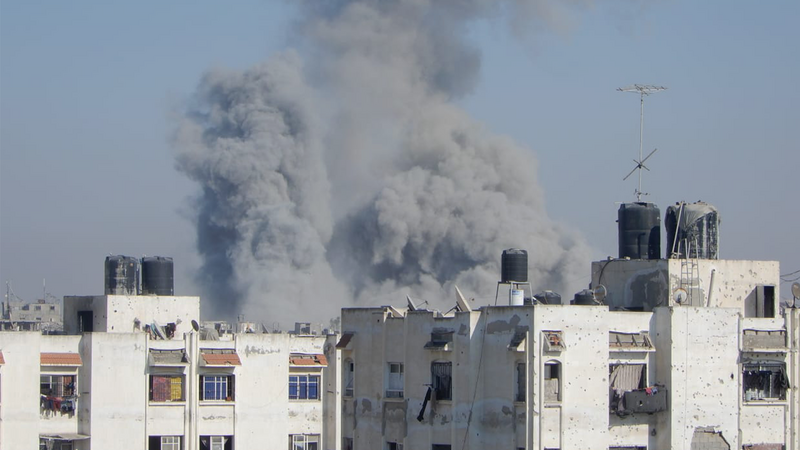The Electronic Intifada 24 June 2025

Israeli airstrikes and ground attacks on Khan Younis in June 2025 forced many residents to evacuate.
The phone call from the Israeli army came on the afternoon of Thursday, 12 June. It was a recording of a male’s voice, in Arabic.
First, in a robotic tone, he listed the numbers of nearby residential blocks in Khan Younis: 63, 64, 100, 107, 108. Then, the voice said: “The Israeli ‘defense’ forces are operating with extreme force in the areas where you are located to destroy the capabilities of terrorist organizations and the enemy. For your safety, evacuate immediately to the shelters in al-Mawasi.”
Every day in Gaza the boundaries between reality and imagination blur, and every moment is a test of endurance. In moments like these I ask myself if I will die, or is there a level of torment I must endure before death.
The previous night, 11 June, we had not yet received any evacuation notice. But the bombings were so close that we heard and felt the explosions from the fifth floor of our apartment in Khan Younis. In the middle of the night, I awoke to three very powerful explosions and I prayed, “Ya Allah, I hope this night ends quickly.”
I had an ear infection, and I could feel the air fill my ears and the pressure build with every explosion. Imagine a giant hammer striking your eardrum, followed by a painful ringing, an incessant buzz that you can feel in your chest and bones.
Our building shook from the force, our furniture dancing across the floor and the windows trembling. With every explosion I could feel the ground move beneath my feet, all the way up on the fifth floor.
In the morning, we could see the aftermath of the explosions. The black-gray smoke from the airstrikes suffocating the horizon; the white smoke from the tank shells snaking horizontally through the buildings. Then, that phone recording instructing us to evacuate.
It felt like the entire city was dying.
A quiet night in Gaza
We tried to get a car out of Khan Younis on 12 June, right after we received the evacuation call, but there were no cars available. I watched from above as those living in the camp below packed up their tents, mattresses and other belongings.
I worked all day, studying and writing. The air smelled like gunpowder instead of morning coffee. I could still feel the pain in my ears and in my brain. In the evening I slept deeply and did not hear any bombings. It was a quiet night in Gaza.
The next day, 13 June, my family and I joined the crowds on Nasser Street to wait for a car. My mother, three sisters and my younger brother waited nearly an hour in the sun for a car because by that time everyone in the area was evacuating.
In my bag I had packed my Palestinian flag and my kuffiyeh. I reminded myself that I am not a displaced person – I am a human being in need of a space to exist and to pursue my goals.
In the car, nobody spoke. We were too tired for that.
Breathing new air
The trip north to al-Zawayda, in the Deir al-Balah governorate, took us more than four hours when before the war it would’ve taken us 15 minutes.
We arrived, exhausted, at my aunt’s house. We asked for water. I felt like I could breathe again. Then we rested and went to sleep. The next day we organized and tidied our things.
Two of my brothers, Hassan and Kareem, had stayed behind to move important things from our house, but they arrived in al-Zawayda two days later.
In the coming days, the internet was out, and I couldn’t reach anybody. Apparently a fiber optic cable in our area had been cut, and we are without internet more than not.
My aunt’s house is overcrowded, though we are grateful to be here. The little ones want to play all the time and touch everything. Sometimes I ask them to play far away because I am in a lecture, but they do not care.
I went to the market with my mother, and I was shocked to see the streets so empty, not crowded like in Khan Younis.
My eyes landed on complete buildings, not crumbling structures. The streets were devoid of tents, and there were no piles of rubble or waste. People moved around somewhat freely, walking, talking, laughing. Their faces did not bear the marks of terror that I had grown accustomed to in Khan Younis.
This does not mean that there is no destruction and shelling in the Middle Area; there are many martyrs every day. However, it is still incomparable to what I witnessed and experienced in Khan Younis.
Explosions in the distance
I miss Khan Younis. I feel a kinship with the city and its people. Its eastern areas are agricultural, and its western areas are densely populated, with houses tightly packed together. The southern areas are quieter, with houses surrounded by green spaces.
I have to say that I am anxious about what will come next. We are trying to find a place to stay that will give us more privacy. My emotions are never settled.
Sometimes, when people here hear the shelling in Khan Younis, they close their ears with their hands and can’t bear the sound. One time, I asked my aunt, “What would you do if you heard the sounds of tanks the way I did?”
Donya Ahmad Abu Sitta is a writer in Gaza.





